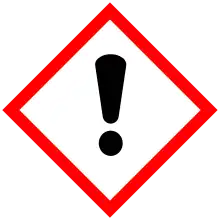| Names | |
|---|---|
| IUPAC name
Tribromoeuropium | |
| Identifiers | |
3D model (JSmol) |
|
| ECHA InfoCard | 100.033.939 |
| EC Number |
|
PubChem CID |
|
CompTox Dashboard (EPA) |
|
| |
| |
| Properties | |
| EuBr3 | |
| Molar mass | 391.68 g[1] |
| Melting point | 702 °C (1,296 °F; 975 K)[1] |
| Will dissolve[2] | |
| Thermochemistry | |
Std molar entropy (S⦵298) |
50.7 ± 3[3] |
Std enthalpy of formation (ΔfH⦵298) |
-186.1 ± 3[3] |
Gibbs free energy (ΔfG⦵) |
-179.3 ± 3[3] |
| Hazards | |
| GHS labelling: | |
 | |
| Warning | |
| H315, H319, H335[4] | |
| P261, P264, P271, P280, P302+P352, P304+P340, P305+P351+P338, P312, P362, P403+P233[4] | |
| NFPA 704 (fire diamond) | |
Except where otherwise noted, data are given for materials in their standard state (at 25 °C [77 °F], 100 kPa).
Infobox references | |
Europium(III) bromide (or europium tribromide) is a crystalline compound, a salt, made of one europium and three bromine atoms.[2] Europium tribromide is a grey powder at room temperature.[2] It is odorless.[5] Europium tribromide is hygroscopic.[6]
Reactions
When vaporized, europium(III) bromide reacts by the equation:
Europium(III) bromide is also created through the equations:
- 4 EuBr2+ 4 HBr → 4 EuBr3 + 2 H2[7]
References
- 1 2 Elements, American. "Europium(III) Bromide". American Elements. Retrieved 21 December 2016.
- 1 2 3 Phillips, Sidney L.; Perry, Dale L. (1995). Handbook of inorganic compounds. Boca Raton: CRC Press. p. 159. ISBN 9780849386718.
- 1 2 3 4 Haschke, John M. "The phase equilibria, vaporization behavior, and thermodynamic properties of europium tribromide". University of Michigan. Department of Chemistry, University of Michigan. Retrieved 23 December 2016.
- 1 2 "Europium(III) Bromide" (PDF). Prochem. Retrieved 21 December 2016.
- ↑ "Europium(III) bromide hydrate, White crystalline, Reaction, 99.99% (REO)". www.fishersci.com. Retrieved 21 December 2016.
- ↑ "Europium (III) Bromide | 13759-88-1". www.chemicalbook.com. Retrieved 21 December 2016.
- 1 2 "Hydrogen Production Options for Water-Cooled Nuclear Power Plants International Conference on Non-Electric Applications of Nuclear Power" (PDF). Argonne. Retrieved 23 December 2016.
This article is issued from Wikipedia. The text is licensed under Creative Commons - Attribution - Sharealike. Additional terms may apply for the media files.
